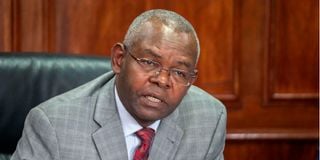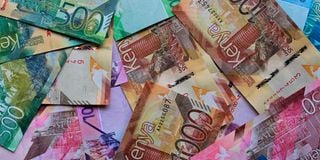Premium
Shilling overvalued for long, CBK governor Kamau Thugge says

Central Bank of Kenya Governor Kamau Thugge.
The Central Bank of Kenya (CBK) says Kenya’s demand for foreign exchange has outweighed supply in most months leading to the depreciation of the Kenya Shilling which crossed the Sh150 mark against the US dollar.
CBK governor Kamau Thugge told Parliament that in April, most of the foreign exchange inflows were utilised in the reduction of the short positions held by commercial banks and unfulfilled demand carried over from previous months.
He said the Kenyan Shilling has for years been overvalued by between 20 to 25 percent according to the International Monetary Fund and the World Bank.

Kenyan currency notes.
“The over-valuation became obvious last year. Inflation last year went beyond what had been seen for decades. The US raised interest rates by 500 basis points,” Dr Thugge said.
“The CBK did not raise the interest rate considerably and there were capital outflows which affected the exchange rate.”
The Kenya shilling on Monday crossed the 150-unit mark following a period of sustained and consistent depreciation that has narrowed the gap between the official and retail selling rates of the US currency.
Since the beginning of the year, the shilling has depreciated by 17.7 percent against the dollar, which is more than double the 8.3 percent it shed against the unit in the whole of 2022.
The CBK indicative rate published Monday morning showed the dollar’s buy price at Sh149.84 and a selling rate of Sh150.04 units, hence an average of 149.94.
Forex bureaus quoted dollar selling prices of between Sh156.50 and Sh157 while buying at between Sh152 and Sh153.
“Most African currencies have weakened against the US dollar, partly reflecting global strengthening of the US dollar,” Dr Thugge told the Finance and National Planning committee.
“Policy tightening in major economies partly contributed to the global strengthening of the US dollar.”
Dr Thugge appeared before the committee chaired by Molo MP Kuria Kimani to explain the measures the CBK is putting in to reverse the depreciation of the Shilling against the US dollar.
Dr Thugge said the Kenyan currency had continued to slide despite the reopening of the interbank dollar market in April and the removal of a CBK rule that capped daily deviation from the indicative rate at 20 cents has helped the exchange rate find its own level through demand and supply.
He said the CBK had written to ten main banks to explain why the spreads were so wide despite the interbank market reforms.
“I have written to ten banks to explain why their spreads are very wide. I expect to receive their responses as to why action should not be taken. Once I receive their responses, I determine the action to be taken,” he said.
Dr Thugge said the CBK has undertaken a number of measures to help strengthen the shilling.
They include a review of Limits on Tenor Swaps and Other Local Currency Funding Instruments.
“The tenor of swaps and Kenya shilling borrowing where non-resident banks are involved is limited to tenor of not less than six months,” he said.
“There is no limit in the tenor of swaps between residents. This includes resident banks within the East African Community.”
Dr Thugge said the CBK has adopted the use of the Electronic Brokerage System in the foreign exchange market.
He said the minimum amount tradeable in the interbank exchange market has been revised from $500,000 to $250,000.
Dr Thugge said the CBK has issued guidance to Money Remittance Providers (MRPs) to enhance interbank liquidity.
He said the selling of foreign exchange by the MRPs to cooperate customers is restricted to a minimum of $100,000 per customer per day.
The CBK said it expects large cash inflows from the International Monetary Fund (IMF), the World Bank and regional development financial institutions to help strengthen the Kenya shilling.
Dr Thugge told MPs that a team from the IMF will visit Kenya next week and the Treasury hopes to get at least $400 million (Sh60 billion).
He said Kenya also expects $530 million from the IMF and the significant amount of the concessional resources will go towards replacing expensive domestic debt that the Treasury has borrowed from local banks.
Dr Thugge said Kenya also expects to receive $750 million (Sh562.5 billion) from the World Bank that is to be disbursed by March next year.
“We expect inflows from multilateral, bilateral and regional development financial institutions. We have a three-year reforms programme with the World Bank. We have engaged the World Bank and IMF to see if there is room for further disbursements,” Dr Thugge said.
“The IMF will be in the country to conduct its 6th review and we expect to see whether they will increase the amount they intend to lend to us.”
Dr Thugge said the CBK recently met with 130 investors in Marrakech, Morocco to convince them that Kenya will pay the Eurobond which falls due in June next year.
“The improved sentiments around the Eurobond and the debt issues saw the interest rate on Eurobond fall from 20 percent to 14.4 percent just two days after meeting the 130 investors,” Dr Thugge said.
“The ongoing engagement with investors, the expected inflows from multilateral, bilateral and regional development financial institutions as well as deliberate measures to improve forex inflows will help us support the shilling from further decline.”





